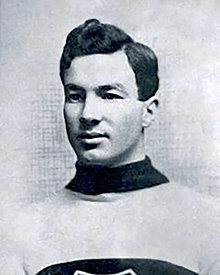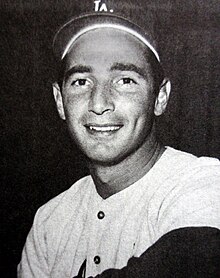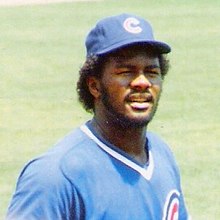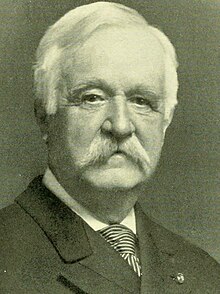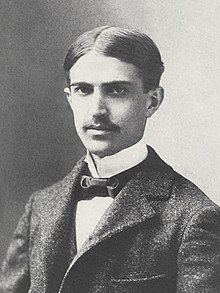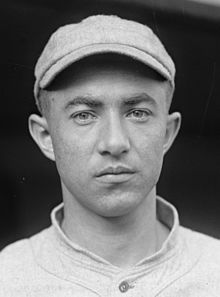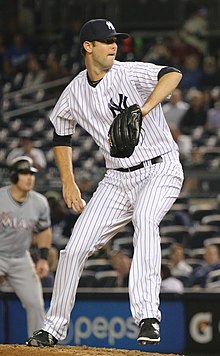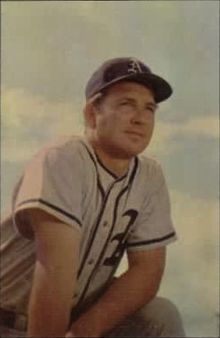Portal:Baseball
Portal maintenance status: (June 2018)
|
| Main page | Content, Categories & Topics | WikiProjects & Things you can do |
The Baseball Portal
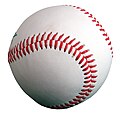
Baseball is a bat-and-ball sport played between two teams of nine players each, taking turns batting and fielding. The game occurs over the course of several plays, with each play generally beginning when a player on the fielding team, called the pitcher, throws a ball that a player on the batting team, called the batter, tries to hit with a bat. The objective of the offensive team (batting team) is to hit the ball into the field of play, away from the other team's players, allowing its players to run the bases, having them advance counter-clockwise around four bases to score what are called "runs". The objective of the defensive team (referred to as the fielding team) is to prevent batters from becoming runners, and to prevent runners' advance around the bases. A run is scored when a runner legally advances around the bases in order and touches home plate (the place where the player started as a batter).
The opposing teams switch back and forth between batting and fielding; the batting team's turn to bat is over once the fielding team records three outs. One turn batting for each team constitutes an inning. A game is usually composed of nine innings, and the team with the greater number of runs at the end of the game wins. Most games end after the ninth inning, but if scores are tied at that point, extra innings are usually played. Baseball has no game clock, though some competitions feature pace-of-play regulations such as the pitch clock to shorten game time.
Baseball evolved from older bat-and-ball games already being played in England by the mid-18th century. This game was brought by immigrants to North America, where the modern version developed. Baseball's American origins, as well as its reputation as a source of escapism during troubled points in American history such as the American Civil War and the Great Depression, have led the sport to receive the moniker of "America's Pastime"; since the late 19th century, it has been unofficially recognized as the national sport of the United States, though in modern times is considered less popular than other sports, such as American football. In addition to North America, baseball spread throughout the rest of the Americas and the Asia–Pacific in the 19th and 20th centuries, and is now considered the most popular sport in parts of Central and South America, the Caribbean, and East Asia, particularly in Japan, South Korea, and Taiwan. (Full article...)
 Featured articles - load new batch
Featured articles - load new batch
-
Image 1
Robert William Andrew Feller (November 3, 1918 – December 15, 2010), nicknamed "the Heater from Van Meter", "Bullet Bob", and "Rapid Robert", was an American baseball pitcher who played 18 seasons in Major League Baseball (MLB) for the Cleveland Indians between 1936 and 1956. In a career spanning 570 games, Feller pitched 3,827 innings and posted a win–loss record of 266–162, with 279 complete games, 44 shutouts, and a 3.25 earned run average (ERA). His career 2,581 strikeouts were third all-time upon his retirement.
A prodigy who bypassed baseball's minor leagues, Feller made his debut with the Indians at the age of 17. His career was interrupted by four years of military service (1942–1945) as a United States Navy Chief Petty Officer aboard USS Alabama during World War II. Feller became the first pitcher to win 24 games in a season before the age of 21. He threw no-hitters in 1940, 1946, and 1951, and 12 one-hitters, both records at his retirement. He helped the Indians win a World Series title in 1948 and an American League-record 111 wins and the pennant in 1954. Feller led the American League in wins six times and in strikeouts seven times. In 1946 he recorded 348 strikeouts, the most since 1904 and then believed to be a record. (Full article...) -
Image 2

Depiction of the game from The Boston Globe
On Saturday, May 1, 1920, the Brooklyn Dodgers and the Boston Braves played to a 1–1 tie in 26 innings, the most innings ever played in a single game in the history of Major League Baseball (MLB). The game was played at Braves Field in Boston before a crowd estimated at 4,000. Both Leon Cadore of Brooklyn and Joe Oeschger of Boston pitched complete games, and with 26 innings pitched, jointly hold the record for the longest pitching appearance in MLB history. Their record is considered unbreakable, as modern pitchers rarely pitch even nine innings, and newer baseball rules have made long extra-innings games a rarity.
The day of the game saw rainy weather, and it was uncertain if the game would be played, but the skies cleared enough to allow it to proceed. Brooklyn scored a run in the fifth inning, and Boston in the sixth; thereafter, the pitchers became increasingly dominant. As the game exceeded eighteen innings, the small crowd at Braves Field cheered both pitchers. The last twenty innings were scoreless, and when darkness started to fall, the umpires called a halt after the twenty-sixth inning, as baseball fields did not yet have artificial lighting. (Full article...) -
Image 3
Robert William Meusel (July 19, 1896 – November 28, 1977) was an American baseball left and right fielder who played in Major League Baseball (MLB) for eleven seasons from 1920 through 1930, all but the last for the New York Yankees. He was best known as a member of the Yankees' championship teams of the 1920s, nicknamed "Murderers' Row", during which time the team won its first six American League (AL) pennants and first three World Series titles.
Meusel, noted for his strong outfield throwing arm, batted fifth behind Baseball Hall of Famers Babe Ruth and Lou Gehrig. In 1925, he became the second Yankee, after Ruth, to lead the AL in home runs (33), runs batted in (138) and extra base hits (79). Nicknamed "Long Bob" because of his 6-foot, 3 inch (1.91 m) stature, Meusel batted .313 or better in seven of his first eight seasons, finishing with a .309 career average; his 1,009 RBI during the 1920s were the fourth most by any major leaguer, and trailed only Harry Heilmann's total of 1,131 among AL right-handed hitters. Meusel ended his career in 1930 with the Cincinnati Reds. He hit for the cycle three times, and was the second of six major leaguers to accomplish this feat as many as three times during a career. (Full article...) -
Image 4Michael Lee Capel (born October 13, 1961) is an American professional baseball pitcher who played in Major League Baseball (MLB) for the Chicago Cubs, the Milwaukee Brewers, and the Houston Astros. In 49 career games, Capel pitched 62+1⁄3 innings, struck out 43 batters, and had a career win–loss record of 3–4 with a 4.62 earned run average (ERA). While he played in MLB, Capel stood at 6 feet 1 inch (185 cm) and weighed 175 pounds (79 kg). A starting pitcher in college and parts of his Minor League Baseball career, he converted to relief pitching while in Chicago's minor league system.
The Philadelphia Phillies chose Capel in the 24th round of the 1980 MLB draft, but the 18-year-old did not sign with the team; instead, he opted to attend the University of Texas. Capel played on the 1982 USA College All-Star Team, which competed in the Amateur World Series in Seoul and placed third. The next year, Capel and the Texas Longhorns won the College World Series. After he was drafted by the Cubs, Capel left Texas and signed to play professional baseball; he played in six seasons of Minor League Baseball before he made his MLB debut in 1988. Capel spent the entire 1989 season in Triple-A, one level below the majors, but the Cubs released him at the end of the year. He agreed to terms with the Brewers and played in MLB after an injury opened a spot on Milwaukee's roster, but was again released at the end of the season. A free agent, the Astros signed Capel, and over the course of the season he pitched in 25 games for the team. He spent the final part of his career in the Astros farm system, and after he made the 1992 Triple-A All-Star team, Capel played his last season in 1993. After retirement, Capel worked as the general manager of a car dealership in Houston, Texas. (Full article...) -
Image 5
George Herman "Babe" Ruth (February 6, 1895 – August 16, 1948) was an American professional baseball player whose career in Major League Baseball (MLB) spanned 22 seasons, from 1914 through 1935. Nicknamed "the Bambino" and "the Sultan of Swat", he began his MLB career as a star left-handed pitcher for the Boston Red Sox, but achieved his greatest fame as a slugging outfielder for the New York Yankees. Ruth is regarded as one of the greatest sports heroes in American culture and is considered by many to be the greatest baseball player of all time. In 1936, Ruth was elected to the Baseball Hall of Fame as one of its "first five" inaugural members.
At age seven, Ruth was sent to St. Mary's Industrial School for Boys, a reformatory where he was mentored by Brother Matthias Boutlier of the Xaverian Brothers, the school's disciplinarian and a capable baseball player. In 1914, Ruth was signed to play Minor League baseball for the Baltimore Orioles but was soon sold to the Red Sox. By 1916, he had built a reputation as an outstanding pitcher who sometimes hit long home runs, a feat unusual for any player in the dead-ball era. Although Ruth twice won 23 games in a season as a pitcher and was a member of three World Series championship teams with the Red Sox, he wanted to play every day and was allowed to convert to an outfielder. With regular playing time, he broke the MLB single-season home run record in 1919 with 29. (Full article...) -
Image 6Ross with the Montreal Wanderers, circa 1907–18
Arthur Howey Ross (January 13, 1885 – August 5, 1964) was a Canadian professional ice hockey player and executive from 1905 until 1954. Regarded as one of the best defenders of his era by his peers, he was one of the first to skate with the puck up the ice rather than pass it to a forward. He was on Stanley Cup championship teams twice in a playing career that lasted thirteen seasons; in January 1907 with the Kenora Thistles and 1908 with the Montreal Wanderers. Like other players of the time, Ross played for several different teams and leagues, and is noted for his time with the Wanderers while they were members of the National Hockey Association (NHA) and its successor, the National Hockey League (NHL). In 1911, he led one of the first organized player strikes over increased pay. When the Wanderers' home arena burned down in January 1918, the team ceased operations and Ross retired as a player.
After several years as an on-ice official, he was named head coach of the Hamilton Tigers for one season. When the Boston Bruins were formed in 1924, Ross was hired as the first coach and general manager of the team. He later coached the team on three separate occasions until 1945, and stayed as general manager until his retirement in 1954. Ross helped the Bruins finish first place in the league ten times and win the Stanley Cup three times; Ross personally coached the team to two of those victories. After being hired by the Bruins, Ross, along with his wife and two sons, moved to a suburb of Boston, and he became an American citizen in 1938. He died near Boston in 1964. (Full article...) -
Image 7
Sanford Koufax (/ˈkoʊfæks/; né Braun; born December 30, 1935), nicknamed "the Left Arm of God", is an American former baseball pitcher who played 12 seasons in Major League Baseball (MLB) for the Brooklyn/Los Angeles Dodgers from 1955 to 1966. Widely regarded as one of the greatest pitchers in baseball history, Koufax was the first three-time winner of the Cy Young Award, each time winning unanimously and the only pitcher to do so when a single award was given for both the leagues; he was also named the National League Most Valuable Player in 1963. Retiring at the age of 30 due to chronic pain in his pitching elbow, Koufax was elected to the Baseball Hall of Fame in his first year of eligibility in 1972 at the age of 36, the youngest player ever elected.
Born in Brooklyn, New York, Koufax was primarily a basketball player in his youth and had pitched in only a few games before signing with the Brooklyn Dodgers at age 19. Due to the bonus rule he signed under, Koufax never pitched the minor leagues. His lack of pitching experience caused manager Walter Alston to distrust Koufax, who saw inconsistent playing time during his first six seasons. As a result, though he often showed flashes of brilliance, Koufax struggled early on. Frustrated with the way he was being managed by the Dodgers, he almost quit after the 1960 season. After making adjustments prior to the 1961 season, Koufax quickly rose to become the most dominant pitcher in the major leagues, as well as the first major sports star on the West Coast. He was an All-Star in each of his last six seasons, leading the National League (NL) in earned run average each of his last five years, in strikeouts four times, and in wins and shutouts three times each. He was the first pitcher in the live-ball era to post an earned run average below 2.00 in three different qualifying seasons, and the first ever to record a 300-strikeout season three times. (Full article...) -
Image 8William Derrick Bates (born December 7, 1963) is an American former professional baseball second baseman and pinch runner who played in Major League Baseball (MLB) for the Milwaukee Brewers and the Cincinnati Reds. In 29 career games, Bates had a batting average of .125 with six hits, two runs batted in (RBI), 11 runs, and eight stolen bases. Though his defensive position was at second base, the Reds primarily used Bates as a pinch runner. After he scored the winning run in Game 2 of the 1990 World Series, Bates never played in MLB again.
Born in Houston, Bates attended the University of Texas and, in his freshman season, won the 1983 College World Series as a part of the Texas Longhorns baseball team. For the next two seasons, Bates was named to the College Baseball All-America Team, a team composed of the best collegiate baseball athletes in America. Drafted by Milwaukee in the fourth round of the 1985 MLB draft, he rose through the Brewers' farm system helping several of his minor league teams win their respective league titles. He made his MLB debut in 1989, after Milwaukee's starting second baseman Jim Gantner was injured. A trade in 1990 sent Bates to Cincinnati, where the Reds used him primarily as a pinch runner at the end of the regular season and into the postseason. Facing the Oakland Athletics in the World Series, Bates reached base on a pinch hit single against Dennis Eckersley and later scored the winning run in Game 2 as the Reds swept the Athletics four games to none. Following the World Series championship, the Reds re-signed Bates on a one-year contract, and he played for their Triple-A team. He spent the next year with the Chicago Cubs Triple-A affiliate, and last played exhibition baseball in 1995. After retiring, he worked as an equipment supplier in the oil and gas industry in Houston. (Full article...) -
Image 9
Lee Arthur Smith (born December 4, 1957) is an American former professional baseball pitcher who played 18 years in Major League Baseball (MLB) for eight teams. Serving mostly as a relief pitcher during his career, he was a dominant closer, was the first pitcher to reach 400 saves, and held the major league record for career saves from 1993 until 2006, when Trevor Hoffman passed his total of 478. He was elected to the National Baseball Hall of Fame as part of the class of 2019 by the Today's Game Era Committee.
A native of Jamestown in Bienville Parish in north Louisiana, Smith was scouted by Buck O'Neil and was selected by the Chicago Cubs in the 1975 MLB draft. Smith was an intimidating figure on the pitcher's mound at 6 feet 6 inches (1.98 m) and 265 pounds (120 kg) with a 95-mile-per-hour (150 km/h) fastball. In 1991, he set a National League (NL) record with 47 saves for the St. Louis Cardinals, and was runner-up for the league's Cy Young Award; it was the second of three times Smith led the NL in saves, and he later led the American League (AL) in saves once. When he retired, he held the major league record for career games finished (802) and was third in games pitched (1,022). He holds the Cubs' team record for career saves (180), and held the same record for the Cardinals (160) until 2006. (Full article...) -
Image 10
Morgan Gardner Bulkeley (December 26, 1837 – November 6, 1922) was an American politician of the Republican Party, businessman, and insurance executive. In 1876, he served as the first president of baseball's National League and, because of that, was inducted into the National Baseball Hall of Fame in 1937, a choice that remains controversial, since his time as a baseball executive was short.
Bulkeley was born in East Haddam, Connecticut. His father was Judge Eliphalet Adams Bulkeley, a prominent local lawyer and businessman, who became the first president of the Aetna Life Insurance Company. The family moved to Hartford, where Morgan Bulkeley was educated, before he took a job in the city of Brooklyn, New York. He served briefly in the American Civil War, where he saw no combat. When his father died in 1872, he moved back to Hartford and became a bank president and a board member of Aetna, becoming its president in 1879, a post he held the rest of his life. (Full article...) -
Image 11The Nashville Sounds Minor League Baseball team was established in Nashville, Tennessee, in 1978, after Larry Schmittou and a group of investors purchased the rights to operate an expansion franchise of the Double-A Southern League. The Sounds played their home games at Herschel Greer Stadium from its opening in 1978 until the end of the 2014 season. In 2015, the Sounds left Greer for First Tennessee Park, now known as First Horizon Park, a new facility located on the site of the historic Sulphur Dell ballpark, home to Nashville's minor league teams from 1885 to 1963.
The Sounds led all of Minor League Baseball in attendance in their inaugural season and continued to draw the Southern League's largest crowds in each of their seven years as members of the league. On the field, the team won six consecutive second-half division titles from 1979 to 1984 and won the Southern League championship twice: in 1979 as the Double-A affiliate of the Cincinnati Reds and again in 1982 as the Double-A affiliate of the New York Yankees. (Full article...) -
Image 12
Stephen Crane (November 1, 1871 – June 5, 1900) was an American poet, novelist, and short story writer. Prolific throughout his short life, he wrote notable works in the Realist tradition as well as early examples of American Naturalism and Impressionism. He is recognized by modern critics as one of the most innovative writers of his generation.
The ninth surviving child of Methodist parents, Crane began writing at the age of four and had several articles published by 16. Having little interest in university studies though he was active in a fraternity, he left Syracuse University in 1891 to work as a reporter and writer. Crane's first novel was the 1893 Bowery tale Maggie: A Girl of the Streets, generally considered by critics to be the first work of American literary Naturalism. He won international acclaim for his Civil War novel The Red Badge of Courage (1895), considered a masterpiece by different critics and writers. (Full article...) -
Image 13Adenhart pitching for the Salt Lake Bees in 2008
Nicholas James Adenhart (August 24, 1986 – April 9, 2009) was an American right-handed baseball starting pitcher who played parts of two seasons in Major League Baseball (MLB) for the Los Angeles Angels of Anaheim. In just four career games, Adenhart pitched 18 innings and posted a win-loss record of 1–0.
A graduate of Williamsport High School, Adenhart was highly touted as a high school prospect until an injury in his final game required Tommy John surgery. The Angels drafted him in the 14th round of the 2004 Major League Baseball draft, and began playing in their minor league system after the surgery was a success. He spent three full seasons in the minor leagues before making his major league debut on May 1, 2008. After appearing in three games, Adenhart spent the rest of 2008 in the minor leagues developing his skills, and in 2009 he earned a spot in the Angels' starting rotation. (Full article...) -
Image 14
Harmon Clayton Killebrew Jr. (/ˈkɪlɪbruː/; June 29, 1936 – May 17, 2011), nicknamed "the Killer" and "Hammerin' Harmon", was an American professional baseball first baseman, third baseman, and left fielder. He spent most of his 22-year career in Major League Baseball (MLB) with the Minnesota Twins. A prolific power hitter, Killebrew had the fifth-most home runs in major league history at the time of his retirement. He was second only to Babe Ruth in American League (AL) home runs, and was the AL career leader in home runs by a right-handed batter. Killebrew was inducted into the National Baseball Hall of Fame in 1984.
Killebrew was 5-foot-11-inch (180 cm) tall and 213 pounds (97 kg). His compact swing generated tremendous power and made him one of the most feared power hitters of the 1960s, when he hit at least 40 home runs per season eight times. In total Killebrew led the league six times in home runs and three times in RBIs, and was named to 13 All-Star teams. In 1965, he played in the World Series with the Twins, who lost to the Los Angeles Dodgers. His finest season was 1969, when he hit 49 home runs, recorded 140 RBIs and won the AL Most Valuable Player Award while helping lead the Twins to the AL West pennant. (Full article...) -
Image 15

On July 10, 1932, the Philadelphia Athletics beat the Cleveland Indians 18–17 in 18 innings in a Major League Baseball game played at League Park in Cleveland. Several major-league records were set during the game; for example, Johnny Burnett of the Indians became the only player to hit safely nine (or even eight) times in a game, while Cleveland's 33 hits and the teams' combined 58 hits are also single-game records. Pitcher Eddie Rommel secured the win for the Athletics, pitching an American League-record 17 innings in relief after Philadelphia's Lew Krausse gave up three runs in the first inning. The 29 hits Rommel allowed are a major-league record; the 14 runs against him are the most given up by a winning pitcher.
Coming into the game, the Athletics, who were the three-time defending American League champions, trailed the New York Yankees in the standings by 71⁄2 games. Sunday baseball was still illegal in Philadelphia, forcing the Athletics to make one-game road trips on some Sundays, including July 10. With his pitching staff exhausted by six games in the previous three days, the owner and manager of the Athletics, Connie Mack, took only two pitchers on the train trip to Cleveland, giving the rest of the staff the day off. With no chance of being relieved except by a position player, Rommel pitched with mixed effectiveness, giving up six runs in the seventh inning but only two runs in the final nine innings of the game. He aided his own cause by getting three hits in seven at bats. Cleveland's Wes Ferrell took the loss after Jimmie Foxx got his sixth hit of the game and then scored. Foxx had already batted in eight runs, having hit three home runs and accumulated sixteen total bases, tying a record that has since been broken. (Full article...)
General images - load new batch
-
Image 2The strike zone, which determines the outcome of most pitches, varies in vertical length depending on the batter's typical height while swinging. (from Baseball rules)
-
Image 3A game from the Cantigas de Santa Maria, c. 1280, involving tossing a ball, hitting it with a stick and competing with others to catch it (from History of baseball)
-
Image 42013 World Baseball Classic championship match between the Dominican Republic and Puerto Rico, March 20, 2013 (from Baseball)
-
Image 5A pitcher handing off the ball after being taken out of the game during a mound meeting. (from Baseball)
-
Image 6The standard fielding positions (from Baseball rules)
-
Image 7An Afghan girl playing baseball in August 2002 (from Baseball)
-
Image 9A first baseman receives a pickoff throw, as the runner dives back to first base. (from Baseball)
-
Image 10A New York Yankees batter (Andruw Jones) and a Boston Red Sox catcher at Fenway Park (from Baseball)
-
Image 11A runner sliding into home plate and scoring. (from Baseball)
-
Image 12Two players on the baseball team of Tokyo, Japan's Waseda University in 1921 (from Baseball)
-
Image 14Baserunners generally stand a short distance away from their base between pitches, preparing themselves to either go back or steal the next base. (from Baseball rules)
-
Image 15Sadaharu Oh managing the Japan national team in the 2006 World Baseball Classic. Playing for the Central League's Yomiuri Giants (1959–80), Oh set the professional world record for home runs with 868. (from History of baseball)
-
Image 16Cy Young—the holder of many major league career marks, including wins and innings pitched, as well as losses—in 1908. MLB's annual awards for the best pitcher in each league are named for Young. (from Baseball)
-
Image 17The typical motion of a right-handed pitcher (from Baseball rules)
-
Image 18Baseball games sometimes end in a walk-off home run, with the batting team usually gathering at home plate to celebrate the scoring of the winning run(s). (from Baseball rules)
-
Image 19Jackie Robinson in 1945, with the era's Kansas City Royals, a barnstorming squad associated with the Negro American League's Kansas City Monarchs (from Baseball)
-
Image 20Pitchers are generally substituted during mound visits (team gatherings at the pitcher's mound). (from Baseball rules)
-
Image 21The NL champion New York Giants baseball team, 1913. Fred Merkle, sixth in line, had committed a baserunning gaffe in a crucial 1908 game that became famous as Merkle's Boner. (from History of baseball)
-
Image 221906 World Series, infielders playing "in" for the expected bunt and the possible play at the plate with the bases loaded (from Baseball rules)
-
Image 23Alexander Cartwright, father of modern baseball (from History of baseball)
-
Image 24Pesäpallo, a Finnish variation of baseball, was invented by Lauri "Tahko" Pihkala in the 1920s, and after that, it has changed with the times and grown in popularity. Picture of Pesäpallo match in 1958 in Jyväskylä, Finland. (from Baseball)
-
Image 25Defensive positions on a baseball field, with abbreviations and scorekeeper's position numbers (not uniform numbers) (from Baseball)
-
Image 26The American Tobacco Company's line of baseball cards featured shortstop Honus Wagner of the Pittsburgh Pirates from 1909 to 1911. In 2007, the card shown here sold for $2.8 million. (from Baseball)
-
Image 27Fenway Park, home of the Boston Red Sox. The Green Monster is visible beyond the playing field on the left. (from Baseball)
-
Image 28A batter follows through after swinging at a pitched ball. (from Baseball rules)
-
Image 29Cover of Official Base Ball Rules, 1921 edition, used by the American League and National League (from Baseball rules)
-
Image 31The strike zone determines the result of most pitches, and varies in vertical length for each batter. (from Baseball)
-
Image 32By the 1860s Civil War, baseball (bottom) had overtaken its fellow bat-and-ball sport cricket (top) in popularity within the United States. (from History of baseball)
-
Image 35In May 2010, the Philadelphia Phillies' Roy Halladay pitched the 20th major league perfect game. That October, he pitched only the second no-hitter in MLB postseason history. (from History of baseball)
-
Image 36Japanese-Americans spectating a World War II-era game while in an internment camp. America's ties to immigrants and to Japan have been deeply shaped by a shared baseball heritage. (from History of baseball)
-
Image 38Sadaharu Oh managing the Japan national team in the 2006 World Baseball Classic. Playing for the Central League's Yomiuri Giants (1959–80), Oh set the professional world record for home runs. (from Baseball)
-
Image 40A well-worn baseball (from Baseball)
-
Image 41Jackie Robinson in 1945, with the era's Kansas City Royals, a barnstorming squad associated with the Negro American League's Kansas City Monarchs (from History of baseball)
-
Image 43Diagram of a baseball field Diamond may refer to the square area defined by the four bases or to the entire playing field. The dimensions given are for professional and professional-style games. Children often play on smaller fields. (from Baseball)
-
Image 44Pick-off attempt on runner (in red) at first base (from Baseball rules)
-
Image 45Rickey Henderson—the major leagues' all-time leader in runs and stolen bases—stealing third base in a 1988 game (from Baseball)
 Good articles - load new batch
Good articles - load new batch
-
Image 1Detmers with the Los Angeles Angels in 2022
Reid Kristien Detmers (born July 8, 1999) is an American professional baseball pitcher for the Los Angeles Angels of Major League Baseball (MLB).
Detmers was born in Nokomis, Illinois, and attended Nokomis High School as well as Glenwood High School, lettering in baseball for four seasons between the two schools. He played college baseball at the University of Louisville for three seasons, earning Atlantic Coast Conference and national accolades by his sophomore season. In his junior year, Detmers was considered one of the top prospects for the MLB draft. He was selected tenth overall by the Angels in the first round of the 2020 draft and signed with the team, forgoing his final year of college eligibility. (Full article...) -
Image 2
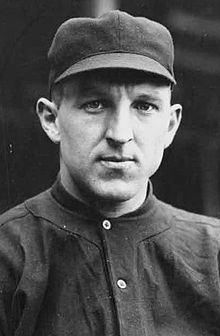
Charles Lincoln "Buck" Herzog (July 9, 1885 – September 4, 1953) was an American infielder and manager in Major League Baseball who played for four National League clubs between 1908 and 1920: the New York Giants, the Boston Braves, the Cincinnati Reds, and the Chicago Cubs. His flexibility sets him apart from other major leaguers, as he demonstrated great skill as a second baseman, shortstop, and third baseman.
Born in Baltimore, Maryland, Herzog grew up on a farm in nearby Ridgely. After attending the Maryland Agricultural College, he played one season in the minor leagues before the Giants selected him in the Rule 5 Draft. Herzog batted .300 as a rookie but struggled in 1909 and was traded to Boston before 1910. He cemented himself as an everyday player over the next two years, then was reacquired by the Giants in 1911, with whom he would reach three straight World Series. He struggled to hit in the 1911 World Series but set a record that would stand for over 50 years with 12 hits in the 1912 World Series, though the Giants lost all three of the series. Traded to the Reds before the 1914 season, he served as a player-manager for the Reds through the first half of the 1916 season, though the team had a losing record in each of those years. The Giants reacquired him halfway through 1916, naming him the team captain. After a famous fight with Ty Cobb during 1917 spring training, he played in his fourth and final World Series, though he made a key error in Game 5 as the Giants were defeated in six games. Herzog spent 1918 with Boston, was traded to Chicago in the middle of 1919, and played one last year with the Cubs in 1920, a season that saw his reputation tarnished by unsubstantiated accusations of gambling on baseball games. (Full article...) -
Image 3
Early Wynn Jr. (January 6, 1920 – April 4, 1999), nicknamed "Gus", was an American professional baseball right-handed pitcher. He played in Major League Baseball (MLB) for the Washington Senators, Cleveland Indians, and Chicago White Sox, during his 23-year MLB career. Wynn was identified as one of the most intimidating pitchers in the game, having combined his powerful fastball with a hard attitude toward batters. He was inducted into the Baseball Hall of Fame in 1972.
Wynn signed with the Senators at the age of 17, deciding to forgo completing his high school education to begin pursuing a baseball career. He spent three seasons in Minor League Baseball (MiLB) before achieving his first MLB stint in 1939. Wynn returned to the big leagues two years later and in 1942 pitched his first full MLB season. The following year, he won 18 games for the Senators. Drafted into the military in 1944, Wynn missed all of 1945 and a portion of the 1946 season while serving in the United States Army during World War II. He spent all of 1947 and 1948 with the Senators before getting traded to the Indians after the 1948 season. (Full article...) -
Image 4Albert Thake (September 21, 1849 – September 1, 1872) was an English professional baseball left fielder for the Brooklyn Atlantics of the National Association. Joining the team in 1872, he played 18 games for them, batting .295 with 14 runs scored, 23 hits, 2 doubles, 2 triples, 0 home runs, 15 runs batted in (RBI), and 2 stolen bases. Thake died on September 1, 1872, when he drowned off the coast of Fort Hamilton while fishing. (Full article...)
-
Image 5Bruce Eugene Kison (February 18, 1950 – June 2, 2018) was an American professional baseball pitcher, who played in Major League Baseball (MLB) for the Pittsburgh Pirates (1971–79), California Angels (1980–84) and Boston Red Sox (1985). Kison won two World Series championships with the Pirates, both over the Baltimore Orioles, and is perhaps best remembered for throwing 6+1⁄3 scoreless innings of relief to win Game 4 of the 1971 World Series. He batted and threw right-handed.
Kison grew up in Pasco, Washington, and was drafted by the Pirates in the 14th round of the 1968 Major League Baseball draft. He reached the major leagues in 1971 and relieved Luke Walker in the first inning of Game 4 of the World Series, throwing 6+1⁄3 scoreless innings as he enabled the Pirates to come from behind to win the game, and ultimately the Series. Bothered by a sore shoulder the next two years, Kison adjusted his delivery in the 1973–74 offseason, becoming a full-time starter by the middle of 1974. In 1976, he set career highs in wins (14) and earned run average (ERA) (3.08). He had a disappointing 1977 season, partly because of hangnail problems, and in 1978, he was moved back to the bullpen to start the year. He regained his rotation spot halfway through the season, though, and proved an important member of the Pirates' rotation once again in 1979, winning the season's final game to send the Pirates to the playoffs. He struggled in his only start of the World Series but won his second World Series ring as the Pirates defeated the Orioles again. (Full article...) -
Image 6
Lewis Everett Scott (November 19, 1892 – November 2, 1960), nicknamed "Deacon", was an American professional baseball player. A shortstop, Scott played in Major League Baseball for 12 seasons as a member of the Boston Red Sox, New York Yankees, Washington Senators, Chicago White Sox and Cincinnati Reds, from 1914 through 1926. Scott batted and threw right-handed.
Scott served as captain of both the Red Sox and Yankees, who have become fierce rivals. He compiled a lifetime batting average of .249, hitting 20 home runs with 551 runs batted in in 1,654 games. He led American League shortstops in fielding percentage seven straight seasons (1916–22) and appeared in 1,307 consecutive games from June 20, 1916, through May 6, 1925, setting a record later broken by Lou Gehrig. As of 2022[update], it is still the third-longest streak in history. (Full article...) -
Image 7Donald Paul Black (July 20, 1916 or 1917 – April 21, 1959) was an American right-handed pitcher in Major League Baseball who played for six seasons in the American League with the Philadelphia Athletics and Cleveland Indians. In 154 career games, Black pitched 797 innings and posted a win–loss record of 34–55, with 37 complete games, four shutouts, and a 4.35 earned run average (ERA).
Born in Salix, Iowa, he played minor league baseball in Fairbury, Nebraska, and Petersburg, Virginia, before signing with the Philadelphia Athletics. He played with them for three seasons before being released. Black signed with the Cleveland Indians at the end of 1945, and after a season with them joined Alcoholics Anonymous. After completing the program, during the off season, he then played two more seasons with Cleveland, pitching a no-hitter on July 10, 1947. On September 13, 1948, Black suffered a cerebral hemorrhage on the field, which marked the end of his professional career. After a comeback attempt, Black went on to become a sports announcer and salesman. He died in 1959. (Full article...) -
Image 8Heyward with the Chicago Cubs in 2016
Jason Alias Heyward (born August 9, 1989), nicknamed "J-Hey", is an American professional baseball outfielder who is a free agent. He has played in Major League Baseball (MLB) for the Atlanta Braves, St. Louis Cardinals, Chicago Cubs, Los Angeles Dodgers and Houston Astros.
Originally the Braves' first-round selection in the 2007 MLB draft from Henry County High School in Georgia, Heyward began his minor league career at age 17. He appeared in three minor league all-star games and won two minor league player of the year awards. In 2010, multiple media outlets named Heyward the top prospect in all of baseball. (Full article...) -
Image 9Martin with the New York Yankees in 2015
Christopher Riley Martin (born June 2, 1986) is an American professional baseball pitcher who is a free agent. He has played in Major League Baseball (MLB) for the Colorado Rockies, New York Yankees, Texas Rangers, Atlanta Braves, Chicago Cubs, Los Angeles Dodgers and Boston Red Sox and in Nippon Professional Baseball (NPB) for the Hokkaido Nippon-Ham Fighters.
Martin played baseball at Arlington High School and McLennan Community College, but gave up on baseball after he suffered a shoulder injury. After working in a warehouse for three years, Martin began playing catch, and felt strong enough to try out for independent league baseball. After he pitched for the Grand Prairie AirHogs in 2010, the Boston Red Sox of MLB signed Martin in 2011. He pitched in Minor League Baseball for the Red Sox organization, until they traded him to the Rockies after the 2013 season. (Full article...) -
Image 10
Alfred Aloysius "Allie" Clark (June 16, 1923 – April 2, 2012) was an American right fielder in Major League Baseball who played for seven seasons in the American League with the New York Yankees, Cleveland Indians, Philadelphia Athletics and Chicago White Sox. In 358 career games, Clark recorded a batting average of .262 and accumulated 32 home runs and 149 runs batted in (RBIs).
Clark was born in South Amboy, New Jersey, where he attended St. Mary's High School, and joined the New York Yankees organization after graduating. He spent the next six seasons playing minor league baseball and serving in the U.S. Army during World War II. He made his major league debut in 1947, and after one year with the Yankees, he spent four seasons with the Cleveland Indians. He was a member of the World Champion Yankees and Indians after the two teams won the 1947 World Series and 1948 World Series, respectively. He then played with the Philadelphia Athletics and Chicago White Sox through 1953, and played minor league baseball until 1958. After retiring, he returned to South Amboy and resided there until his death in 2012. (Full article...) -
Image 11
Jayson Richard Gowan Werth (born May 20, 1979) is an American former professional baseball outfielder who played in Major League Baseball (MLB) from 2002 to 2017. His 15-season career was split among the Toronto Blue Jays, Los Angeles Dodgers, Philadelphia Phillies, and the Washington Nationals.
Born in Springfield, Illinois, Werth was a third-generation baseball player, as his great-grandfather and grandfather had both played professional baseball, as had his uncle and stepfather. His time catching for Glenwood High School led to an athletic scholarship to play college baseball with the Georgia Bulldogs, which he turned down after the Baltimore Orioles selected him in the 1997 MLB Draft. Werth played in the Orioles' farm system until 2001, when he was traded to the Blue Jays as part of a package for John Bale. Werth made his MLB debut with the Blue Jays in 2002, and split time between the majors and minors until he was traded to the Dodgers in 2004. (Full article...) -
Image 12
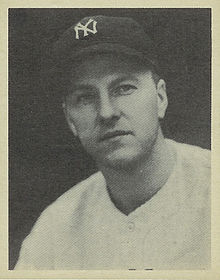
Montgomery Marcellus Pearson (September 2, 1908 – January 27, 1978) was an American baseball pitcher who played ten seasons in Major League Baseball (MLB). Nicknamed "Hoot", he played for the Cleveland Indians, New York Yankees and Cincinnati Reds from 1932 to 1941. He batted and threw right-handed and served primarily as a starting pitcher.
Pearson played minor league baseball for three different teams until 1932, when he signed with the Cleveland Indians. After spending four seasons with the organization, Pearson was traded to the New York Yankees, where he spent the next five years. At the conclusion of the 1940 season, he was traded to the Cincinnati Reds, with whom he played his last game on August 5, 1941. A four-time World Series champion, Pearson holds the MLB record for lowest walks plus hits per inning pitched (WHIP) in the postseason. He is noted for pitching the first no-hitter at the original Yankee Stadium. (Full article...) -
Image 13Joseph Arlo Gray (November 8, 1915 – May 11, 1999) was an American football back. He attended Roosevelt High School in Oregon, where he was a two-time first-team All-Portland Interscholastic League (PIL) selection, and enrolled at Oregon State University in 1934. Nicknamed "the Gray Ghost", he played college football for the Oregon State Beavers and was a first-team All-Pacific Coast Conference (PCC) performer and second-team All-American. He was selected in the first round (10th overall) of the 1938 NFL draft by the Chicago Bears, but never played professionally. (Full article...)
-
Image 14"Homer at the Bat" is the seventeenth episode of the third season of the American animated television series The Simpsons. It originally aired on Fox in the United States on February 20, 1992. The episode follows the Springfield Nuclear Power Plant softball team, led by Homer, having a winning season and making the championship game. Mr. Burns makes a large bet that the team will win and brings in nine ringers from the "big leagues" to ensure his success.
The episode was written by John Swartzwelder and directed by Jim Reardon. Roger Clemens, Wade Boggs, Ken Griffey Jr., Steve Sax, Ozzie Smith, Jose Canseco, Don Mattingly, Darryl Strawberry, and Mike Scioscia all guest starred as themselves, playing the ringers hired by Mr. Burns. Terry Cashman sang "Talkin' Softball", a modified version of his song "Talkin' Baseball", over the end credits. "Homer at the Bat" underwent a lengthy production, as the guest stars were recorded over several months in accordance with their availability. Most of the players were accommodating except for Canseco, who demanded that his part be rewritten. (Full article...) -
Image 15
Timothy Scott Baker (born September 19, 1981) is an American former professional baseball starting pitcher. He stands 6 feet 4 inches (1.93 m) tall and weighs 215 pounds (98 kg). He played in Major League Baseball (MLB) for the Minnesota Twins, Chicago Cubs, Texas Rangers and Los Angeles Dodgers. He bats and throws right-handed.
Baker grew up in Shreveport, Louisiana, and attended Oklahoma State University. He was drafted by the Twins in the second round of the 2003 Major League Baseball draft and reached the major leagues in 2005. In 2006, he made their starting rotation out of Spring training but struggled and was sent to the minor leagues for most of the rest of the season. Beginning 2007 in the minors, he was called up in May and nearly threw a perfect game on August 31. He went 11–4 in 2008 and posted a 3.45 earned run average (ERA). In 2009, Baker logged a career-high 200 innings and started the American League (AL) tiebreaker game against the Detroit Tigers which the Twins won to advance to the postseason. He had a 12–9 record in 2010 but battled injuries towards the end of the year and was left out of the Twins' postseason rotation. Injuries limited Baker in 2011 again, but he was the only Twins' pitcher to post a winning record. He missed 2012 after undergoing Tommy John surgery; this also caused him to miss most of 2013, which he spent with the Chicago Cubs. He began 2014 in the minor leagues but was later added to the Texas Rangers' roster. Baker started eight games for the Rangers but was used mainly as a relief pitcher. In 2015, he signed with the New York Yankees but was released before the season started. Signed by the Los Angeles Dodgers, he started two games for them, the last appearances of his major league career. (Full article...)
Did you know (auto-generated) - load new batch

- ... that Dr. Twink Twining was a Major League Baseball player?
- ... that a painting by Major League Baseball player Gene Locklear was hung in the White House?
- ... that Major League Baseball pitcher Charlie Gray was billed as his team's pitcher "of six fingers and six toed fame" and called "a freak" by the Sporting Life?
- ... that before Sean Jackson won three Ivy League basketball championships, he won high school state championships in both baseball and basketball?
- ... that Corky Palmer coached the Southern Miss Golden Eagles to their only College World Series appearance in 2009?
- ... that under a rules draft presented at the 1857 baseball convention, baseball bats would have been allowed to be shaved flat on one side?
- ... that Devin Futrell used a post to dodge a draft?
- ... that Benny Lefebvre had three sons who signed professional baseball contracts and four brothers who played football?
Quotes
| "90% of the game is half mental." |
 Featured lists - load new batch
Featured lists - load new batch
-
Image 1
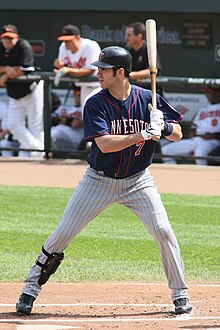
Joe Mauer, the Twins' first-overall selection in the 2001 draft, won an MVP, two Gold Gloves, three Silver Sluggers, and three batting titles.
The Minnesota Twins are a Major League Baseball (MLB) franchise based in Minneapolis, Minnesota. They play in the American League Central division. Since the institution of MLB's Rule 4 Draft, the Twins have selected 70 players in the first round. Officially known as the "First-Year Player Draft", the Rule 4 Draft is MLB's primary mechanism for assigning players from high schools, colleges, and other amateur clubs to its franchises. The draft order is determined based on the previous season's standings, with the team possessing the worst record receiving the first pick. In addition, teams which lost free agents in the previous off-season may be awarded compensatory or supplementary picks.
Of the 70 players picked in the first round by Minnesota, 30 have been pitchers, the most of any position; 22 of these were right-handed, while 8 were left-handed. Twelve outfielders were selected, while twelve shortstops, seven third basemen, four catchers, four first basemen and one player at second base were taken as well. Thirteen of the players came from high schools or universities in the state of California, and Florida follows with nine players. The Twins have drafted six players from Arizona, including five players from Arizona State University. (Full article...) -
Image 2

Tim Lincecum (2006) won two Cy Young Awards with the Giants.
The San Francisco Giants are a Major League Baseball (MLB) franchise based in San Francisco, California. They play in the National League West division. Officially known as the "First-Year Player Draft", the Rule 4 Draft is MLB's primary mechanism for assigning players from high schools, colleges, and other amateur clubs to its franchises. The draft order is determined based on the previous season's standings, with the team possessing the worst record receiving the first pick. In addition, teams which lost free agents in the previous off-season may be awarded compensatory or supplementary picks. Since the establishment of the draft in 1965, the Giants have selected 70 players in the first round.
Of those 70 players, 32 have been pitchers, the most of any position; 23 of these were right-handed, while 9 were left-handed. The Giants have also selected thirteen outfielders, seven shortstops, seven catchers, four third basemen, and three players each at first and second base. One player, 2010 selection Gary Brown, was drafted as a center fielder. The franchise has drafted eight players from colleges or high schools in their home state of California, more than any other. The Giants have never held the first-overall pick, but they did have the second pick in 1985, with which they drafted Will Clark. (Full article...) -
Image 3The 1971 Cy Young Award won by Ferguson Jenkins, on display in the Canadian Baseball Hall of Fame
The Cy Young Award is given annually to the best pitchers in Major League Baseball (MLB), one each for the American League (AL) and National League (NL). The award was introduced in 1956 by Baseball Commissioner Ford C. Frick in honor of Hall of Fame pitcher Cy Young, who died in 1955. The award was originally given to the single best pitcher in the major leagues, but in 1967, after the retirement of Frick, the award was given to one pitcher in each league.
Each league's award is voted on by members of the Baseball Writers' Association of America (BBWAA). Local BBWAA chapter chairmen in each MLB city recommend two writers to vote for each award. Final approval comes from the BBWAA national secretrary-treasurer. Writers vote for either the American League or National League awards, depending on the league in which their local team plays. A total of 30 writers vote for each league's awards. Writers cast their votes prior to the start of postseason play. (Full article...) -
Image 4

In baseball, a home run is credited to a batter when he hits a fair ball and reaches home safely on the same play, without the benefit of an error. Sixty-two different players have hit two home runs in an inning of a Major League Baseball (MLB) game to date, the most recent being Brent Rooker of the Oakland Athletics on May 4, 2024. Regarded as a notable achievement, five players have accomplished the feat more than once in their career; no player has ever hit more than two home runs in an inning. Charley Jones was the first player to hit two home runs in one inning, doing so for the Boston Red Stockings against the Buffalo Bisons on June 10, 1880.
These innings have resulted in other single-inning and single-game MLB records being set due to the prodigious offensive performance. Bobby Lowe and Mike Cameron finished their respective games with a total of four home runs, equaling the record for most home runs in one game. Both of the home runs hit by Fernando Tatís in the third inning for the St. Louis Cardinals on April 23, 1999, were grand slams. Not only did he tie the record for most grand slams in one game, Tatís became the only player to hit two grand slams in the same inning and established a new major league record with eight runs batted in (RBI) in a single inning. A decade later, Alex Rodriguez set the single-inning American League record for RBIs with seven when he hit a three-run home run and a grand slam in the sixth inning for the New York Yankees on October 4, 2009. (Full article...) -
Image 5
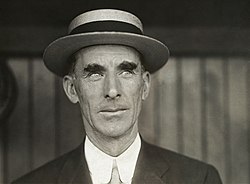
Connie Mack holds the records for most wins (3,731) and losses (3,948) by a Major League Baseball manager.
Major League Baseball (MLB) is the highest level of play in North American professional baseball and is the organization that operates the National League and the American League. In 2000, the two leagues were officially disbanded as separate legal entities, and all of their rights and functions were consolidated in the commissioner's office. Since that time, MLB has operated as a single league. Composed of 30 teams, MLB is one of the four major professional sports leagues in the United States and Canada.
Each team in the league has a manager who is responsible for team strategy and leadership on and off the field. Assisted by various coaches, the manager sets the line-up and starting pitcher before each game and makes substitutions throughout the game. In early baseball history, it was not uncommon for players to fill multiple roles as player-managers; specifically, they managed the team while still being signed to play for the club. The last player-manager in Major League Baseball was Pete Rose, who began managing the Cincinnati Reds in 1984. (Full article...) -
Image 6On November 17, 1992, during the 1992–93 offseason, Major League Baseball (MLB) held an expansion draft in New York City to allow two expansion teams, the Florida Marlins and Colorado Rockies, to build their rosters prior to debuting in the National League's (NL) East and West divisions, respectively, in the 1993 MLB season.
The 1990 collective bargaining agreement between MLB owners and the MLB Players Association allowed the NL to expand by two members to match the American League (AL). In June 1991, MLB accepted bids of groups from Miami, Florida, and Denver, Colorado, with debuts set for 1993. (Full article...) -
Image 7
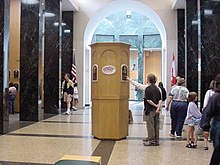
The plaque gallery at the Baseball Hall of Fame
The National Baseball Hall of Fame and Museum in Cooperstown, New York, honors individuals who have excelled in playing, managing, and serving the sport, and is the central point for the study of the history of baseball in the United States and beyond, displaying baseball-related artifacts and exhibits. Elections of worthy individuals to be honored by induction into the Hall of Fame commenced in 1936, although the first induction ceremonies were not held until the hall opened in 1939. Through the elections for 2024, a total of 346 people will have been inducted, including 274 former professional players, 39 executives/pioneers, 23 managers, and 10 umpires. Each is listed showing his primary position; that is, the position or role in which the player made his greatest contribution to baseball according to the Hall of Fame.
According to the current rules, players must have at least 10 years of major league experience to be eligible for induction. In addition, they must be retired for at least five years if living, or deceased for at least six months. Players meeting these qualifications must pass through a screening committee, and are then voted on by the Baseball Writers' Association of America (BBWAA). Each writer may vote for up to 10 players; to be admitted into the Hall of Fame, a player must be approved by 75% of those casting ballots. Players receiving less than 5% approval are removed from future BBWAA ballots. The rules, as revised in July 2016, allow that all individuals eligible for induction but not for the BBWAA ballot—players who have not been approved by the BBWAA election process within 15 years of their retirement, umpires, managers, pioneers, and executives—may be considered by one of four voting bodies that have taken over the role of the former Veterans Committee, based on the era in which each individual candidate made his greatest contribution to the sport. On a few occasions, exceptions have been made to the guidelines in place at the time: Lou Gehrig was elected in 1939 following his diagnosis of amyotrophic lateral sclerosis; Roberto Clemente was elected shortly after his death in 1972; and Addie Joss was elected in 1978 even though he completed only nine seasons before his death. (Full article...) -
Image 8

Randy Johnson, the Opening Day starter from 1999 to 2004
The Arizona Diamondbacks are a Major League Baseball (MLB) franchise based in Phoenix, Arizona. They play in the National League West division. The first game of the new baseball season for a team is played on Opening Day, and being named the Opening Day starter is an honor, which is often given to the player who is expected to lead the pitching staff that season, though there are various strategic reasons why a team's best pitcher might not start on Opening Day. The Diamondbacks have used 10 different Opening Day starting pitchers in their 21 seasons. The 10 starters have a combined Opening Day record of eight wins, seven losses (8–7), and six no decisions. No decisions are only awarded to the starting pitcher if the game is won or lost after the starting pitcher has left the game.
Randy Johnson holds the Diamondbacks' record for most Opening Day starts with six, and has an Opening Day record of 3–2. Brandon Webb started four Opening Days, and Ian Kennedy has been the Opening Day starter thrice. Andy Benes, Javier Vázquez, Dan Haren, and Wade Miley have started one Opening Day each. Kennedy has the best winning percentage as the Opening Day starting pitcher with a record of 2–0. Benes, Vázquez, and Miley are tied for the worst Opening Day record, at 0–1. Webb is Arizona's only pitcher with multiple no-decisions on Opening Day (three), and Johnson is the only pitcher to have won three or more opening games. (Full article...) -
Image 9

Mark Buehrle has made nine Opening Day starts for the Chicago White Sox, including in 2010.
The Chicago White Sox are a Major League Baseball franchise based in Chicago. They play in the American League Central division. The White Sox have used 62 Opening Day starting pitchers since they were established as a Major League team in 1901. The first game of the new baseball season for a team is played on Opening Day, and being named the Opening Day starter is an honor, which is often given to the player who is expected to lead the pitching staff that season, though there are various strategic reasons why a team's best pitcher might not start on Opening Day. The White Sox have a record of 60 wins and 53 losses in their Opening Day games, through the 2013 season.
The White Sox have played in three different home ball parks. They played at South Side Park from 1901 through the middle of 1910, the first Comiskey Park from 1910 through 1990, and have played at the second Comiskey Park, now known as U.S. Cellular Field, since 1991. They had a record of four wins and two losses in Opening Day games at South Side Park, 18 wins and 19 losses at the first Comiskey Park and four wins and one loss at U.S. Cellular Field, for a total home record in Opening Day games of 27 wins and 22 losses. Their record in Opening Day away games is 33 wins and 31 losses. (Full article...) -
Image 10

Jason Varitek in 2009 with the captain insignia on his chest
The Boston Red Sox, a professional baseball franchise in Major League Baseball (MLB), has given the title of captain to select players since the team's inaugural season as a member of the American League in 1901 (the team was known as the Boston Americans through the 1907 season). For various seasons during the team's history, the position has been vacant; while in early baseball a captain was responsible for many of the functions now assumed by managers and coaches, the title is purely honorary in modern professional baseball. Since the end of World War II, only three players have served as captain of the Red Sox. The most recent was catcher Jason Varitek, who was captain during the 2005–2011 seasons, and wore a distinctive "C" on the left side of his jersey, similar to captains in the National Hockey League. (Full article...) -
Image 11
The Major League Baseball All-Star Game Most Valuable Player (MVP) Award is an annual Major League Baseball (MLB) award that is presented to the most outstanding player in each year's MLB All-Star Game. Awarded each season since 1962 (two games were held and an award was presented to each game winner in 1962), it was originally called the Arch Ward Memorial Award in honor of Arch Ward, the man who conceived of the All-Star Game in 1933. The award's name was changed to the Commissioner's Trophy in 1970, but this name change was reversed in 1985 when the World Series Trophy was renamed the Commissioner's Trophy. Finally, the trophy was renamed the Ted Williams Most Valuable Player Award in 2002, in honor of former Boston Red Sox player Ted Williams, who had died earlier that year. No award was presented for the 2002 All-Star Game, which ended in a tie. Thus, the Anaheim Angels' Garret Anderson was the first recipient of the newly named Ted Williams Award in 2003. The All-Star Game Most Valuable Player also receives a Chevrolet vehicle.
As of 2023[update], NL players have won the award 28 times (including one award shared by two players), and American League (AL) players have won 33 times. Baltimore Orioles players have won the most awards for a single franchise (with six); players from the Cincinnati Reds, Los Angeles Dodgers and San Francisco Giants are tied for the most in the NL with five each. Five players have won the award twice: Willie Mays (1963, 1968), Steve Garvey (1974, 1978), Gary Carter (1981, 1984), Cal Ripken Jr. (1991, 2001), and Mike Trout (2014, 2015, becoming the only player to win the award in back-to-back years). The award has been shared by multiple players once; Bill Madlock and Jon Matlack shared the award in 1975. Two players have won the award for a game in which their league lost: Brooks Robinson in 1966 and Carl Yastrzemski in 1970. One pair of awardees were father and son (Ken Griffey Sr. and Ken Griffey Jr.), and another were brothers (Roberto Alomar and Sandy Alomar Jr.). Three players have won the MVP award at a game played in their home ballpark (Sandy Alomar Jr. in 1997, Pedro Martínez in 1999, and Shane Bieber in 2019). Derek Jeter is the only player to win the All-Star Game MVP and World Series MVP in the same season, doing so in 2000. (Full article...) -
Image 12

Ken Griffey Jr. was the first pick overall in the 1987 draft, a 13-time All-Star selection during his career, and a first-ballot Hall of Fame inductee in 2016.
The Seattle Mariners are a Major League Baseball (MLB) franchise based in Seattle, Washington. They play in the American League West division. Since the franchise entered the league as an expansion team in 1977, they have selected 47 players in the first round. Officially known as the "First-Year Player Draft", the Rule 4 Draft is Major League Baseball's primary mechanism for assigning amateur baseball players from high schools, colleges, and other amateur baseball clubs to its teams. The draft order is determined based on the previous season's standings, with the team possessing the worst record receiving the first pick. In addition, teams that lost free agents in the previous off-season may be awarded compensatory or supplementary picks. The First-Year Player Draft is unrelated to the 1976 expansion draft through which the Mariners filled their roster.
Of the 47 players selected in the first round by the Mariners, 18 have been pitchers, the most of any position; of whom 13 were right-handed and five left-handed. They have also drafted nine outfielders, eight shortstops, seven catchers, three first basemen and two third baseman. Seattle has never drafted a second baseman in the first round. The Mariners have drafted 22 players out of high school, and 24 out of college. All of the college selections came from four-year institutions; the team has never selected a junior college player in the first round. The Mariners have drafted 11 players from high schools or colleges in California, four players from Florida, and a single player from their home state of Washington. One of the Mariners' 2007 picks—Canadian Phillippe Aumont—is the only selection from outside the United States. (Full article...) -
Image 13The Atlanta Braves are a professional baseball team based in Atlanta, Georgia. The Braves are members of the National League (NL) East division in Major League Baseball (MLB). Since the franchise started as the Boston Red Stockings (no relationship to the current Boston Red Sox team) in 1871, the team has changed its name several times and relocated twice. The Braves were a charter member of the NL in 1876 as the Boston Red Caps, and are one of the NL's two remaining charter franchises (the other being the Chicago Cubs). In baseball, the head coach of a team is called the manager, or more formally, the field manager. The duties of the team manager include team strategy and leadership on and off the field. The Braves franchise has employed 45 managers.
The franchise's first manager was Hall of Famer Harry Wright, who managed the team for eleven seasons. Frank Selee was the next manager to have managed the team for eleven seasons, with a total of twelve with the formerly named Boston Beaneaters. The formerly named Boston Braves made their first postseason appearance under George Stallings in 1914, winning the World Series that year. Several other managers spent long tenures with the Braves. Bill McKechnie managed the Braves from 1930 to 1937, while Casey Stengel managed the team from 1938 to 1942. The franchise was known as the Boston Bees from 1936 to 1940, and was again named the Boston Braves until 1952. Stengel also managed the Braves in 1943. (Full article...) -
Image 14Mariano Rivera won the AL Relief Man Award in 1999, 2001, 2004, 2005, and 2009.
The Rolaids Relief Man Award was an annual Major League Baseball (MLB) award given from 1976 to 2012 to the top relief pitchers of the regular season, one in the American League (AL) and one in the National League (NL).
Relief pitchers enter the game after the starting pitcher is removed. The award was sponsored by the antacid brand Rolaids, whose slogan was "R-O-L-A-I-D-S spells relief." Because the first closers were nicknamed "firemen", a reference to "putting out the fire" of another team's rally, the trophy was a gold-plated firefighter's helmet. (Full article...) -
Image 15
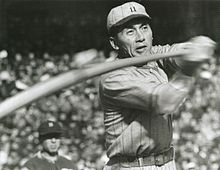
Fumio Fujimura was the first player in Nippon Professional Baseball history to hit for the cycle and also the first to hit multiple cycles.
In baseball, completing the cycle is the accomplishment of hitting a single, a double, a triple, and a home run in the same game. Collecting the hits in that order is known as a "natural cycle", which has occurred five times in Nippon Professional Baseball (NPB). The cycle itself is rare in NPB, occurring 76 times since Fumio Fujimura's first cycle during the single league era in 1948. In terms of frequency, the cycle is roughly as common as a no-hitter (90 occurrences in NPB history); Baseball Digest calls it "one of the rarest feats in baseball". Hitting for the cycle was not recognized in Japanese professional baseball until former Major League Baseball (MLB) player Daryl Spencer made a remark about it after hitting for the cycle with the Hankyu Braves in 1965. Of the 12 current NPB teams, only the Tohoku Rakuten Golden Eagles have never had at least one player hit for the cycle.
The most cycles hit by a player in Nippon Professional Baseball is three, accomplished by Bobby Rose. Playing for the Yokohama BayStars, Rose hit his first cycle on May 2, 1995, the next on April 29, 1997, and his final cycle on June 30, 1999. Other than Rose, only three other NPB players have hit multiple cycles: Fumio Fujimura with the Osaka Tigers and Hiromi Matsunaga with the Hankyu/Orix Braves and Kosuke Fukudome with the Chunichi Dragons and the Hanshin Tigers, all with two. Fujimura is also the only player to have hit a cycle during both the single league era and the current dual league era. The 2003 NPB season saw the most cycles hit in a single season—five. That season also saw the only instance of cycles occurring in two different games on the same day: on July 1, hit by Atsunori Inaba of the Yakult Swallows and Arihito Muramatsu of the Fukuoka Daiei Hawks. The next day, Shinjiro Hiyama became the third player to hit for the cycle in two days. Conversely, the longest period of time between two players hitting for the cycle is one day shy of 6 years. The drought has lasted from Michihiro Ogasawara's cycle in 2008 until Rainel Rosario's in 2014. (Full article...)
More did you know
- ... that despite its author keeping detailed journals of his experiences, the baseball memoir Odd Man Out was criticized by many people named in the book as being factually inaccurate?
- ... that the longest extra inning game in professional baseball history was an International League game that lasted 33 innings?
- ... that two members of the $100,000 infield have been inducted into the Baseball Hall of Fame?
- ... that three of the four batters faced by Mike Palagyi in his one Major League game were later inducted into the Baseball Hall of Fame?
- ... that Boston Red Sox third baseman Will Middlebrooks is engaged to a former Dallas Cowboys cheerleader whom he has known since childhood?
Sports portals
Selected picture
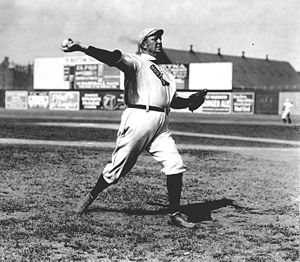
| Credit: George Grantham Bain |
Denton True "Cy" Young (March 29, 1867 – November 4, 1955) was an American baseball player who pitched for five different major league teams from 1890 to 1911. During his 22-year career, Young established numerous professional pitching records in the majors, some of which have stood for a century. Young retired with 511 career wins, 94 wins ahead of Walter Johnson, who is second on the list of most wins in Major League history. In honor of Young's contributions to Major League Baseball (MLB), the Cy Young Award, an annual award given to the pitcher voted the most effective in each of the two leagues, was created in 1956. Young was also elected to the Baseball Hall of Fame in 1937.
Associated Wikimedia
The following Wikimedia Foundation sister projects provide more on this subject:
-
Commons
Free media repository -
Wikibooks
Free textbooks and manuals -
Wikidata
Free knowledge base -
Wikinews
Free-content news -
Wikiquote
Collection of quotations -
Wikisource
Free-content library -
Wikiversity
Free learning tools -
Wiktionary
Dictionary and thesaurus
More portals
- Portals with triaged subpages from June 2018
- All portals with triaged subpages
- Portals with no named maintainer
- Automated article-slideshow portals with 51–100 articles in article list
- Automated article-slideshow portals with 501–1000 articles in article list
- Random portal component with 41–50 available subpages
- Automated article-slideshow portals with 201–500 articles in article list
- Random portal component with 11–15 available subpages
- Random portal component with 21–25 available image subpages







